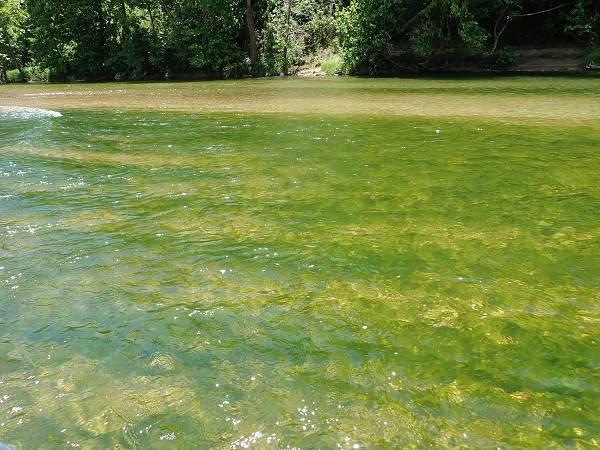News Release
You are viewing ARCHIVED content published online before January 20, 2025.
Please note that this content is NOT UPDATED, and links may not work. For current information,
visit https://www.nps.gov/aboutus/news/index.htm.

NPS Photo
|
Subscribe
|
Contact: Shawn Hodges, 870-365-2778
The Buffalo River continues to experience significant algal growth this summer as hot and dry conditions persist. Most algae is harmless, but certain types can make people and pets sick if they swim in or drink water in close proximity to the algae. This year a species of blue-green algae (also called cyanobacteria) has been identified within the river. This species has the potential to produce cyanotoxins, which can be harmful to humans and pets. Unfortunately, you cannot tell if the algae would produce cyanotoxins just by looking at it.A few visitors have reported illnesses after swimming in areas with algae this month. The National Park Service (NPS) has been working closely with the US Public Health Service (USPHS) and the Arkansas Department of Health (ADH) to determine the causes of the reported illnesses. The testing conducted so far has not identified a pathogen directly linked to algae; however, we are continuing to explore more extensive testing options with the Centers for Disease Control and Prevention (CDC).
We are also sampling the river to determine the abundance of potentially harmful algae and cyanotoxins. On July 17, Arkansas Department of Environmental Quality (ADEQ) sampled 4 sites in the middle and lower districts of the river, including downstream of Spring Creek and at Dillard’s Ferry, for two common cyanotoxins (Microcystin and Cylindrospermopsin). The values in the Buffalo River were below the detectable thresholds of 0.1 micrograms/L for Microcystins and 0.04 micrograms/L for Cylindrospermopsin. These values are far below the EPA draft recreation values for concern for these toxins (4.0 micrograms/L for Microcystins and 10.0 micrograms/L for Cylindrospermopsin).
The park is not posting signs at this time based on these results, but we are issuing press releases and updating our website with general information. We understand that algae can change rapidly as conditions evolve. For these reasons, the NPS, US Geological Survey, ADEQ, and partners will continue to sample additional sites in the river for cyanobacteria and cyanotoxins in the coming months.
Visitors are urged to remain aware of their surroundings and avoid swimming in areas with heavy algae coverage. If children are present, ensure they do not allow water into their mouth or swallow water from the river or tributaries. Visitors should practice CDC recommendations for purifying water used for consumption. Find more information at https://www.nps.gov/articles/2wayspurifywater.htm
The NPS and USPHS encourage visitors who believe they or their animals have become ill after exposure to algae in the Buffalo River, to report the illness during business hours to the ADH Communicable Disease Nurse at 501-537-8969. After hours, people can call the ADH Emergency Communication Center at 1-800-651-3493. Visitors can also report illnesses to the NPS Epidemiology Branch Chief for the Office of Public Health, at e-mail us
Park staff continues to work with other state and federal agencies to address this issue. As more information becomes available, it will be shared widely. Visitors can help this effort by reporting algae along the river via the ADEQ algae reporting forms either on their app or via the web at:
● Nuisance Algae Bloom Complaint Form:
https://www.adeq.state.ar.us/complaints/forms/nuisance_algae_complaint.aspx
● Harmful Algae Bloom Complaint Form: https://www.adeq.state.ar.us/complaints/forms/harmful_algae_complaint.aspx
Last updated: August 11, 2018
